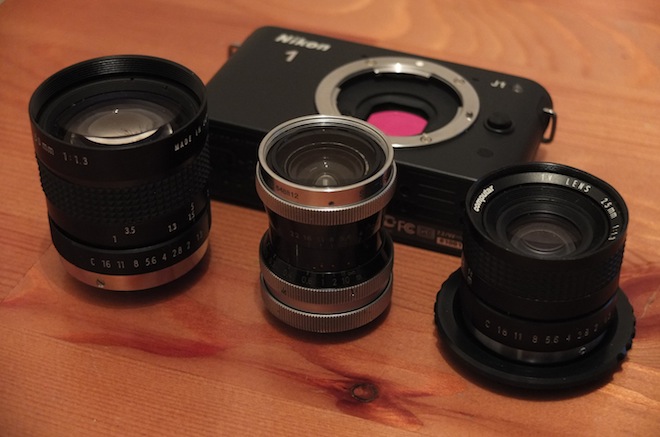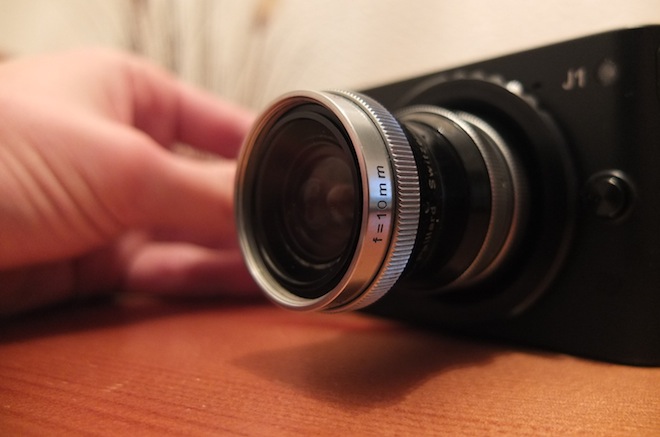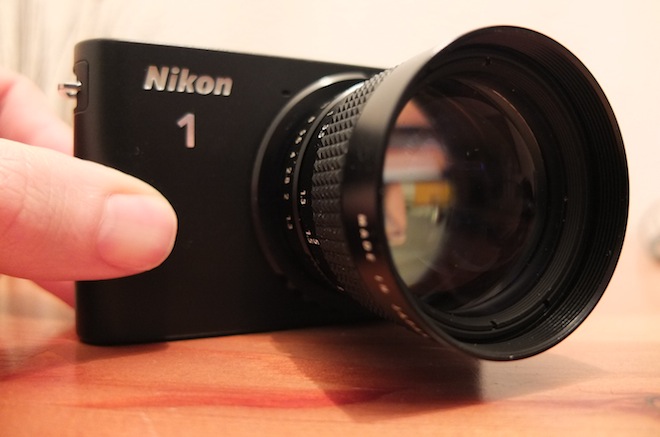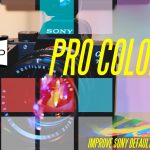
I have the idea to make a tense but beautiful low light, budget thriller with the Nikon J1. It is ideally suited to it. It has the least amount of rolling shutter for handheld camera movement of all the DSLRs and mirrorless cameras, and the smaller sensor (2.7x crop) makes it far easier to focus at fast apertures like F1.2 for low light. At that aperture on full frame you will have a nose in focus, but eyes off! Not much good.
The video, my first test of the Nikon J1, is just a bit of fun using tiny 16mm film c-mount lenses, set to a part of the sound track for Vertigo.
I used the Nikon J1 because all of the beautiful c-mount glass here just cannot be made proper use of on a DSLR.
I’ve used one very old 16mm Bolex lens for the wide angle shots which vignette slightly and wide open it is quite low contrast and dreamy, giving it an authentic 1950’s cinema feel.
This is the mighty Kern Switar 10mm F1.6 and it just about focusses to infinity on the Nikon J1. With a subject beyond 3m away you don’t need to touch the focus, even at F1.6 and it gives you a pleasantly restrained depth of field for normal medium-range shots – not ridiculously shallow. When your subject is close up within 1m you do get some nice bokeh but the background is not completely creamed out, all in a all a nice effect. Sometimes you want to show what is behind your subject – be at iconic scenery or a shadowy figure creeping up with an axe.
I’m using Ceicio7’s adapter (pictured top) made in Poland (Buy it now). It is solid, precise and actually very affordable for just $35.
The other primes I’m using (to the left and right of the Kern Switar above) are Computar video lenses which are like the modern Cosina Voigtlanders of CCTV lens world. Impressivly sharp even wide open, very fast apertures (both F1.3!) and focus to infinity. I am not sure if they do so out of the box though. Mine are modified for infinity focus on the GH2, and actually go slightly past infinity on the Nikon J1. The modification involves removing a small screw under the rubber focus ring grip so that the focus ring turns past infinity.
The Computar 25mm F1.3 and 50mm F1.3 are made in Japan and mechanically are pretty good too with a 100% metal construction and smooth de-clicked manual aperture ring. They are TV lenses actually (not CCTV) so you can happily adjust the aperture smoothly during a shot. I never do that for my shoots but for run & gun it can be helpful when moving around an area with a lot of varying lighting conditions.
If you want to take stills or movies with the J1 and c-mount you have to make sure the camera is set to M (manual) mode. Anything relying on auto exposure like P, A, S won’t work and the camera will just display a message crying about its lens being lost.
Believe me you will want to lose the kit lens if you are doing low light stuff. Almost all the c-mount glass you can adapt to the Nikon J1 are brighter than the Nikon CX lenses available, it really was a crummy effort by Nikon there.

Above: this photo was taken with Fuji X10 (best compact I have ever owned… Review soon)
This camera is very cheap and simplified for Latte Mums but you DO get full manual control in video mode. However less well heeled is the manner in which the camera handles Europeans. It handles us with about as much tact as a burly German bouncer at a night club. There only frame rates are 30p and 60p, and the camera requires the shutter to be set at 1/100(!) otherwise you get terrible flickering / strobing with PAL electric lights. The GH2 has this too in 24p but not as bad and you can use 1/25 and 1/50 to get around it on all but the most stubbornly European of lights. 1/100 isn’t much good for low light and natural looking motion blur is it Nikon?
1/60 is the minimum shutter if you enjoy flickering lights. In America and Asia you can use 1/60 just fine – most of the time.

Above: Computar 50mm F1.3 on the Nikon J1
Unfortunately the camera doesn’t have 24p (NIKON!!!) – except for 2 seconds in a weird ‘moving photo snapshot’ format that works in auto-only and only with the kit lens
But image quality wise the J1 is actually pretty damned good. Not quite at the GH2 level for resolution and the beautifully resolved detail that camera (uniquely) can do, but it has less moire than on the current Canon DSLRs and nice colour, decent dynamic range. It is of course a much smaller sensor than that found in the NEX 7, and the GH2 but with c-mounts that is an advantage. On the NEX my Computar 50mm F1.3 vignettes. On the GH2 my 25mm does so slightly and the 10mm Switar does so wildly. On the J1 that 10mm is a usable atmospheric fast wide!
Surprisingly the Nikon’s sensor is pretty good in low light, quite clean even at ISO 1600 for video.
It is also extremely fast – it does 4K RAW stills at 60fps. Yes you read that correctly.
The catch? Memory and heat restraints mean that it does so for only 1 second, and 30fps at 2 seconds. It does however use a electronic shutter for 4K stills, which is quite an advancement for the breed – no mechanical shutter. This is one reason why the rolling shutter skew on the J1 is so minimal in video mode – the fast sensor output and optimised electronic shutter.
That this sensor (made by Aptina, not Nikon) is in a $400 consumer camera is pretty amazing. Now all it needs is to be backed up with some serious CPU power, large buffer RAM and better cooling – and you have your 4K video for under $2000, possibly even less. That would sell like hot cakes, but nobody in the world seems to have both the vision and the means to make one! Frustrating!
As it is, 4K stills at just 1 second burst is not a feature I’ll be using very often.
Advice for Nikon
The J1 mirrorless can be a better video camera just by adding a articulated screen and better firmware. Those minimum shutter speeds of 1/60 for NTSC and 1/100 for PAL need to be dropped. Take it down to at least 1/30.
Add 24p and 25p because 30p just looks rubbish. (I’ve Twixtored more than I wanted to in the above video just to get rid of the kinetic 30fps video look and to make it more dreamy).
Make it usable in P,A and S modes without a CX lens attached – or at least give us some proper fast primes.
Forget about 400fps – make it 120fps and up the resolution. The image is hideous and usable in slow mo video mode at 400fps. With such a fast sensor think how much more detailed the image could be if they dropped the frame rate by 3x to something a bit more sensible.
Give us a live HDMI output while recording. Not difficult in 2012!
And finally PLEASE put a dedicated ISO button on the camera. At the moment it is buried in the menus. I can understand the need to keep a low end camera like this simple, but Nikon could have at least made one of the existing buttons programmable like the delete key in the bottom right or have it on the F function key. Otherwise the usability and menus are spot on and really nice to use, as well as being some of the most responsive on a mirrorless or DSLR I’ve ever used. Build quality isn’t bad either, and the buttons and scroll wheel feel good to use.
I can see the Nikon J1 being kept for my Hitchcock low light thriller… If only to use those beautiful vintage c-mount lenses on a true 16mm sized sensor. It is something of a ‘speciality’ camera, and somewhat experimental, but it is nice to have the choice over my usual DSLRs and well worth such a low price tag.


